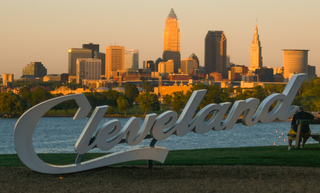
Cleveland, officially the City of Cleveland, is a city in the U.S. state of Ohio and the county seat of Cuyahoga County. Located in Northeast Ohio along the southern shore of Lake Erie, it is situated across the U.S. maritime border with Canada and lies approximately 60 miles (97 km) west of Pennsylvania. Cleveland ranks as the most populous city on Lake Erie, the second-most populous city in Ohio, and the 54th-most populous city in the U.S. with a 2020 population of 372,624. The city anchors the Cleveland metropolitan area, the 33rd-largest in the U.S. at 2.18 million residents, as well as the larger Cleveland–Akron–Canton combined statistical area, the most populous in Ohio and the 17th-largest in the country with a population of 3.63 million in 2020.
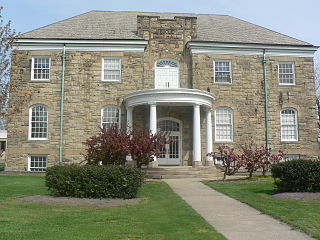
Euclid is a city in Cuyahoga County, Ohio, United States. Located on the southern shore of Lake Erie, it is an inner ring suburb of Cleveland. The population was 49,692 at the 2020 census, making it the fourth largest city in Cuyahoga County.

George Victor Voinovich was an American politician who served as a United States senator from Ohio from 1999 to 2011. He previously served as the 65th governor of Ohio from 1991 to 1998 and as the 54th mayor of Cleveland from 1980 to 1989, the last Republican to serve in that office.
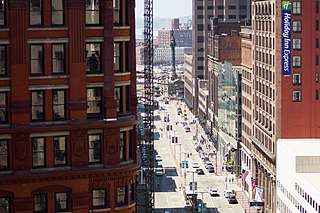
Euclid Avenue is a major street in Cleveland, Ohio, United States. It runs northeasterly from Public Square in Downtown Cleveland, passing Playhouse Square and Cleveland State University, to University Circle, the Cleveland Clinic, Severance Hall, Case Western Reserve University's Maltz Performing Arts Center, Case Western Reserve University and University Hospitals Case Medical Center. The street runs through the suburbs of East Cleveland, Euclid, and Wickliffe, to Willoughby as a part of U.S. Route 20 and U.S. Route 6. The HealthLine bus rapid transit line runs in designated bus lanes in the median of Euclid Avenue from Public Square to Louis Stokes Station at Windermere in East Cleveland.
The Cleveland Short Line Railway is a freight bypass around southern Cleveland, Ohio, in the United States. A quasi-independent railroad organized by major shareholders of the Lake Shore and Michigan Southern Railway, the shortline was intended to allow the Lake Shore and Michigan Southern to bypass the congested railroads in downtown Cleveland. The Cleveland Short Line has had a succession of owners, and is currently part of CSX Transportation.
Collinwood High School is a public high school located in the Collinwood neighborhood on the east side of Cleveland, Ohio, United States. It is part of the Cleveland Metropolitan School District. The school is divided into three academies: Advanced Placement Academy, STEM Teaching Professions Academy, and Academy of Interior and Fashion Design.

Glenville is a neighborhood on the East Side of Cleveland, Ohio. To the north, it borders the streetcar suburb of Bratenahl, the Cleveland Memorial Shoreway, and the Lake Erie shore, encompassing the Cleveland Lakefront Nature Preserve. To the east, it borders the suburb of East Cleveland, and to the south, it borders the neighborhoods of Hough and University Circle. Glenville borders the Collinwood area to the northeast at East 134th Street, and St. Clair–Superior to the west at Martin Luther King Jr. Boulevard and the Cleveland Cultural Gardens in Rockefeller Park.

East 105th Street and Euclid Avenue was at one time the most famous intersection in the city of Cleveland, Ohio. The legendary commercial junction consists of several blocks from East to West between 107th Street and 105th Street.

Hough is a neighborhood situated on the East Side of Cleveland, Ohio. Roughly two square miles, the neighborhood is bounded to Superior and Euclid Avenue between East 55th and East 105th streets. Placed between Downtown Cleveland and University Circle, Hough borders Fairfax and Cedar–Central to the South and Glenville and St. Clair–Superior to the North. The neighborhood became a target for revitalization during the mid-20th century, after the 1966 Hough Riots.
The Village of Nottingham, Ohio was located in Euclid Township, Cuyahoga County, Ohio. It was one of a string of villages along the railroad running east from Cleveland, Ohio. Nottingham was annexed into Cleveland in 1912.

This article is a timeline of the history of the city of Cleveland, Ohio, USA.

The Wade Park District is an historic district on the National Register of Historic Places, located in the University Circle neighborhood on the east side of Cleveland, Ohio. The district, which covers roughly 650 acres, is bounded by Chester Avenue and Euclid Avenue on the south, East Boulevard to the east and E. 105th Street to the west. The district, which includes seven separate buildings, features several of the city's cultural institutions, as well as the park of the same name.
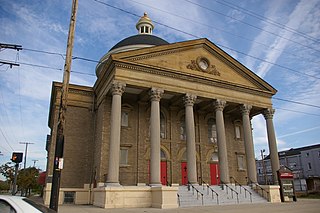
Central, also known as Cedar–Central, is a neighborhood on the East Side of Cleveland, Ohio. Situated on the outskirts of downtown, Central is bounded roughly by East 71st Street on its east and Interstate 90 on its west, with Euclid Avenue on its north and Interstate 77 and the Penn Central Railroad to the south. The neighborhood is named after its onetime main thoroughfare, Central Avenue. It is home to several schools, including East Technical High School.

Fairfax is a neighborhood on the East Side of Cleveland, Ohio. It is roughly bounded between Euclid Avenue to the north, Woodland Avenue to the south, E. 71st Street to the west and E. 105th Street to the east. Fairfax is located on the edge of University Circle, an area containing Cleveland's major educational institutions and museums. The Karamu House is on the National Register of Historic places and is the nation's oldest African-American theater. The northeastern quadrant of Fairfax, along Euclid Avenue to 105th Street, is dominated by the Cleveland Clinic.
The Beachland Ballroom and Tavern is a music venue located in the Collinwood neighborhood of Cleveland, Ohio, United States. It was founded by Cindy Barber and Mark Leddy.
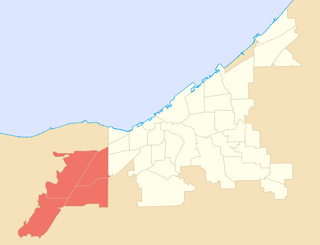
West Park is a historical area on the West Side of Cleveland, Ohio. Once an independent municipality, it was annexed by Cleveland after a referendum in 1923. The area covers 12.5 square miles and is bounded by West 117th Street to the east, the Rocky River Valley to the west, Brookpark Road to the South, and the streetcar suburb of Lakewood to the north. The Cleveland City Planning Commission traditionally divides West Park into four neighborhoods: Jefferson, Kamm's Corners, Bellaire–Puritas, and Hopkins.
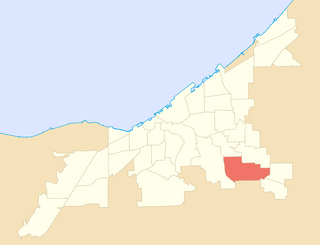
Union–Miles Park is a neighborhood on the Southeast side of Cleveland, Ohio, in the United States. The neighborhood draws its name from Union Avenue, and Miles Park in its far southwest corner.
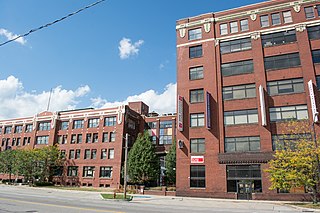
Goodrich–Kirtland Park is a neighborhood on the East Side of Cleveland, Ohio. Roughly bounded between Euclid Avenue to the south, E. 55th Street to the east, I-90 to the west, and Lake Erie and Burke Lakefront Airport to the north.

The transportation system of Cleveland is a network that includes several modes of transportation including sidewalks, roads, public transit, bicycle paths and regional and international airports.

Euclid–Green is a neighborhood on the Northeast side of Cleveland, Ohio. It is "shaped somewhat like an isosceles triangle" and is bounded by the neighborhood of Collinwood–Nottingham to the northwest, the suburb of Euclid to the northeast, and the suburbs of South Euclid, Cleveland Heights, and East Cleveland to the south.


















